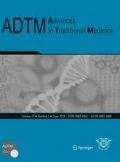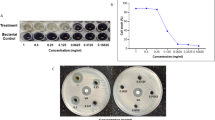Abstract
The spread of multidrug-resistant Gram-negative (MDR) bacteria is a global public health problem, as infections caused by MDR Gram-negative bacteria are difficult to treat. New antibiotic agents need to be developed to overcome this problem, and phytochemicals show promise at this point. In this study, methanol extracts were prepared from cinnamon, thyme, nettle, white tea, rosehip, and antibacterial activity of the methanol extracts was studied against two MDR Gram-Negative bacteria (K. pneumoniae and A. baumannii) by broth microdilution method. The MICs of methanol extracts of cinnamon, rosehip, thyme, white tea for A. baumannii were found as 0.015125 g/ml, 0.07825 g/ml, 0.030625 g/ml, 0.00796875 g/ml, respectively. It was found that only cinnamon methanol extract had antibacterial activity in the used extract concentrations against K. pneumoniae and the MIC value was 0.0605 g/ml. The effects of plant methanol extract with antibacterial activity and imipenem combinations were studied in vitro using the checkerboard method. The FIC Indexes were obtained from the checkerboard results and it was observed that the combination of methanol extract and imipenem showed an antagonistic or additive/indifferent effect but not a synergistic effect. We evaluated the binding affinity of epigallocatechin 3-gallate, quercetin, cinnamaldehyde, carvacrol, and thymol phytocompounds using in silico methods, which are well known as a phytocompounds in white tea, cinnamon, thyme, nettle, and rosehip and have antibacterial activities. The results suggested that these phytocompounds should be supported with in vivo and in vitro experiments to investigate their potential for being inhibitor candidates.




Similar content being viewed by others
References
Aboulmagd E, Al-Mohammed H, Al-Badry S (2011) Synergism and postantibiotic effect of green tea extract and imipenem against methicillin-resistant Staphylococcus aureus. Microbiol J 1:89–96
Averill F, Painter G (1992) Steepest-descent determination of occupation numbers and energy minimization in the local-density approximation. Phys Rev B 46:2498
Bal Ç (1999) Antibiyotik Kombinasyonlarının In vitro Etkinliğinin Saptanması Flora İnfeksiyon Hastalıkları ve Klinik Mikrobiyoloji Dergisi 4:219–229
Bassetti M, Peghin M, Vena A, Giacobbe DR (2019) Treatment of infections due to MDR Gram-negative bacteria. Front Med 6:74
Berman H et al (2000) The protein data Bank nucleic acids research 28:235–242. https://www.rcsb.org
Bonapace CR, White RL, Friedrich LV, Bosso JA (2000) Evaluation of antibiotic synergy against Acinetobacter baumannii: a comparison with Etest, time-kill, and checkerboard methods. Diagn Microbiol Infect Disease 38:43–50
Case D et al (2014) (2014) AMBER 14. University of California, San Francisco
Chuah E, Zakaria Z, Suhaili Z, Bakar SA, Desa M (2014) Antimicrobial activities of plant extracts against methicillin-susceptible and methicillin-resistant Staphylococcus aureus. J Microbiol Res 4:6–13
Cicek AC, Saral A, Iraz M, Ceylan A, Duzgun A, Peleg A, Sandalli C (2014) OXA-and GES-type β-lactamases predominate in extensively drug-resistant Acinetobacter baumannii isolates from a Turkish University Hospital. Clin Microbiol Infect 20:410–415
Dhama K et al (2014) Evidence based antibacterial potentials of medicinal plants and herbs countering bacterial pathogens especially in the era of emerging drug resistance: an integrated update. Int J Pharmacol 10:1–43
Dhara L, Tripathi A (2020) Cinnamaldehyde: a compound with antimicrobial and synergistic activity against ESBL-producing quinolone-resistant pathogenic Enterobacteriaceae. Eur J Clin Microbiol Infect Diseases 39:65–73
Doi Y (2019) Treatment options for carbapenem-resistant gram-negative bacterial infections. Clin Infect Dis 69:565–575
El-Hosseiny L, El-Shenawy M, Haroun M, Abdullah F (2014) Comparative evaluation of the inhibitory effect of some essential oils with antibiotics against Pseudomonas aeruginosa. Int J Antibiot
Eliopoulos GM, Maragakis LL, Perl TM (2008) Acinetobacter baumannii: epidemiology, antimicrobial resistance, and treatment options. Clin Infect Diseases 46:1254–1263
Evans BA, Amyes SG (2014) OXA β-Lactamases. Clin Microbiol Rev 27:241–263
Ev (2021) The European Committee on Antimicrobial Susceptibility Testing. Breakpoint tables for interpretation of MICs and zone diameters
Fadli M, Saad A, Sayadi S, Chevalier J, Mezrioui N-E, Pagès J-M, Hassani L (2012) Antibacterial activity of Thymus maroccanus and Thymus broussonetii essential oils against nosocomial infection–bacteria and their synergistic potential with antibiotics. Phytomedicine 19:464–471
Fankam AG, Kuiate J-R, Kuete V (2017) Antibacterial and antibiotic resistance modulatory activities of leaves and bark extracts of Recinodindron heudelotii (Euphorbiaceae) against multidrug-resistant Gram-negative bacteria. BMC Complement Altern Med 17:1–6
Fankam AG, Kuiate JR, Kuete V (2015) Antibacterial and antibiotic resistance modifying activity of the extracts from Allanblackia gabonensis, Combretum molle and Gladiolus quartinianus against Gram-negative bacteria including multi-drug resistant phenotypes. BMC Complement Altern Med 15:1–12
Forli W, Halliday S, Belew R, Olson AJ (2012) AutoDock Version 4.2. J Med Chem 55:623–638
Ginovyan M, Trchounian A (2019) Novel approach to combat antibiotic resistance: evaluation of some Armenian herb crude extracts for their antibiotic modulatory and antiviral properties. J Appl Microbiol 127:472–480
Hacioglu M, Dosler S, Tan ASB, Otuk G (2017) Antimicrobial activities of widely consumed herbal teas, alone or in combination with antibiotics: an in vitro study. PeerJ 5:e3467
Howard A, O’Donoghue M, Feeney A, Sleator RD (2012) Acinetobacter baumannii: an emerging opportunistic pathogen. Virulence 3:243–250
Hu Z-Q, Zhao W-H, Asano N, Yoda Y, Hara Y, Shimamura T (2002) Epigallocatechin gallate synergistically enhances the activity of carbapenems against methicillin-resistant Staphylococcus aureus. Antimicrob Agents Chemother 46:558–560
Kaskatepe B, Kiymaci ME, Suzuk S, Erdem SA, Cesur S, Yildiz S (2016) Antibacterial effects of cinnamon oil against carbapenem resistant nosocomial Acinetobacter baumannii and Pseudomonas aeruginosa isolates. Ind Crops Prod 81:191–194
Keynan Y, Rubinstein E (2007) The changing face of Klebsiella pneumoniae infections in the community. Int J Antimicrob Agents 30:385–389
Khan I et al (2020) Antimicrobial potential of the food-grade additive carvacrol against uropathogenic E. coli based on membrane depolarization, reactive oxygen species generation, and molecular docking analysis. Microbial Pathog 142:104046
Khazaei M, Khazaei M, Pazhouhi M (2020) An overview of therapeutic potentials of Rosa canina: a traditionally valuable herb. WCRJ 7:e1580
Koulenti D, Song A, Ellingboe A, Abdul-Aziz MH, Harris P, Gavey E, Lipman J (2019) Infections by multidrug-resistant Gram-negative Bacteria: What’s new in our arsenal and what’s in the pipeline? Int J Antimicrob Agents 53:211–224
Liu DC, Nocedal J (1989) On the limited memory BFGS method for large scale optimization. Math Program 45:503–528
Magiorakos A-P et al (2012) Multidrug-resistant, extensively drug-resistant and pandrug-resistant bacteria: an international expert proposal for interim standard definitions for acquired resistance. Clin Microbiol Infect 18:268–281
Maier JA, Martinez C, Kasavajhala K, Wickstrom L, Hauser KE, Simmerling C (2015) ff14SB: improving the accuracy of protein side chain and backbone parameters from ff99SB. J Chem Theory Comput 11:3696–3713
Martyna GJ, Klein ML, Tuckerman M (1992) Nosé-Hoover chains: The canonical ensemble via continuous dynamics. J Chem Phys 97:2635–2643
Morris GM, Goodsell DS, Halliday RS, Huey R, Hart WE, Belew RK, Olson AJ (1998) Automated docking using a Lamarckian genetic algorithm and an empirical binding free energy function. J Comput Chem 19:1639–1662
Mugnier PD, Poirel L, Naas T, Nordmann P (2010) Worldwide dissemination of the blaOXA-23 Carbapenemase gene of Acinetobacter baumannii1. Emerg Infect Diseases 16:35
Nocedo-Mena D, Garza-González E, González-Ferrara M, del Rayo C-C (2020) Antibacterial activity of Cissus incisa extracts against multidrug-resistant bacteria. Curr Top Med Chem 20:318–323
Osterburg A, Gardner J, Hyon S, Neely A, Babcock G (2009) Highly antibiotic-resistant Acinetobacter baumannii clinical isolates are killed by the green tea polyphenol (–)-epigallocatechin-3-gallate (EGCG). Clin Microbiol Infect 15:341–346
Paczosa MK, Mecsas J (2016) Klebsiella pneumoniae: going on the offense with a strong defense. Microbiol Mol Biol Rev 80:629–661
Radji M, Agustama RA, Elya B, Tjampakasari CR (2013) Antimicrobial activity of green tea extract against isolates of methicillin–resistant Staphylococcus aureus and multi–drug resistant Pseudomonas aeruginosa. Asian Pacific J Trop Biomed 3:663–667
Raei P et al (2017) Thymol and carvacrol strongly inhibit biofilm formation and growth of carbapenemase-producing Gram negative bacilli. Cell Mol Biol (noisy-Le-Grand) 63:108–112
Salehzadeh A, Asadpour L, Naeemi AS, Houshmand E (2014) Antimicrobial activity of methanolic extracts of Sambucus ebulus and Urtica dioica against clinical isolates of methicillin resistant Staphylococcus aureus African Journal of Traditional. Complement Altern Med 11:38–40
Santiago C (2015) Application of plant metabolites to overcome antibiotic resistance of methicillin resistant Staphylococcus aureus (MRSA). University of Nottingham
Schrödinger L (2015) The PyMOL molecular graphics system, version 1.8. November
Silva DM, Costa PA, Ribon AO, Purgato GA, Gaspar D-M, Diaz MA (2019) Plant extracts display synergism with different classes of antibiotics. Anais da Acad Brasil de Ciênc 91
Smith CA et al (2013) Structural basis for carbapenemase activity of the OXA-23 β-lactamase from Acinetobacter baumannii. Chem Biol 20:1107–1115
Torol S, Kasap M (2013) Purification and characterization of OXA-23 from Acinetobacter baumannii. J Enzyme Inhibit Med Chem 28:836–842
Usman Amin M et al (2016) Effects of luteolin and quercetin in combination with some conventional antibiotics against methicillin-resistant Staphylococcus aureus. Int J Mol Sci 17:1947
Wang J, Wolf RM, Caldwell JW, Kollman PA, Case DA (2004) Development and testing of a general amber force field. J Comput Chem 25:1157–1174
Acknowledgements
The authors thank the Trabzon Fatih State Hospital and Dr. Tuba Kose for providing Acinetobacter baumannii and Klebsiella pneumoniae isolates. Numerical calculations including MD simulations were carried out at TUBITAK ULAKBIM (TURKEY), High Performance, and Grid Computing Center (TRUBA). This study was supported by grants from Artvin Coruh University (BAP- 2018.F83.02.03).
Author information
Authors and Affiliations
Corresponding author
Ethics declarations
Ethical statement
This article does not contain any studies involving animals performed by any of the authors. This article does not contain any studies involving human participants performed by any of the authors.
Conflict of interest
Eda Aydemir has no conflict of interest. Emrah Sarıyer has no conflict of interest. Esma Akyıldız has no conflict of interest. Azer Özad Düzgün has no conflict of interest. Yasemin Camadan has no conflict of interest. Ayşegül Saral Sarıyer has no conflict of interest.
Additional information
Publisher's Note
Springer Nature remains neutral with regard to jurisdictional claims in published maps and institutional affiliations.
Rights and permissions
About this article
Cite this article
Aydemir, E., Sarıyer, E., Akyıldız, E. et al. In vitro and in silico evaluation of some plant extracts and phytocompounds against multidrug-resistant Gram-negative bacteria. ADV TRADIT MED (ADTM) 22, 749–759 (2022). https://doi.org/10.1007/s13596-021-00602-6
Received:
Accepted:
Published:
Issue Date:
DOI: https://doi.org/10.1007/s13596-021-00602-6




